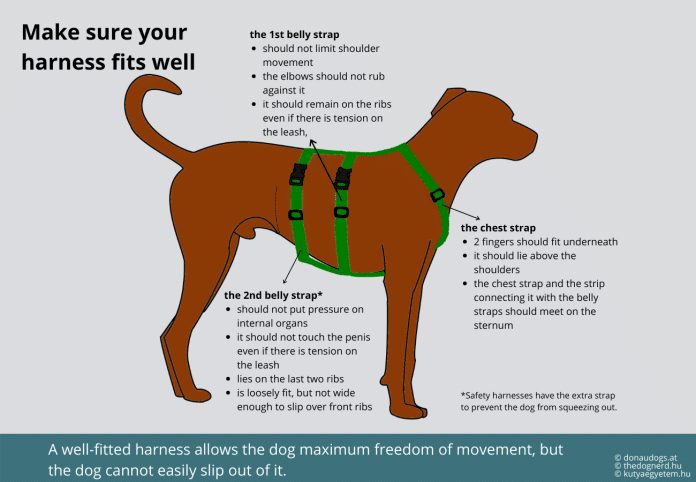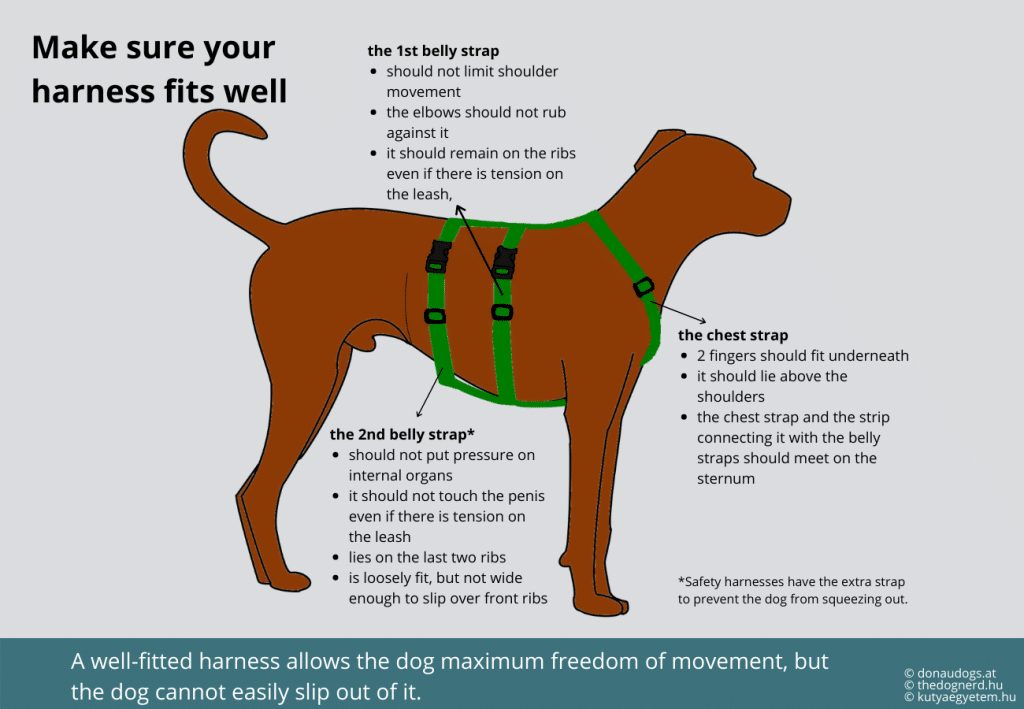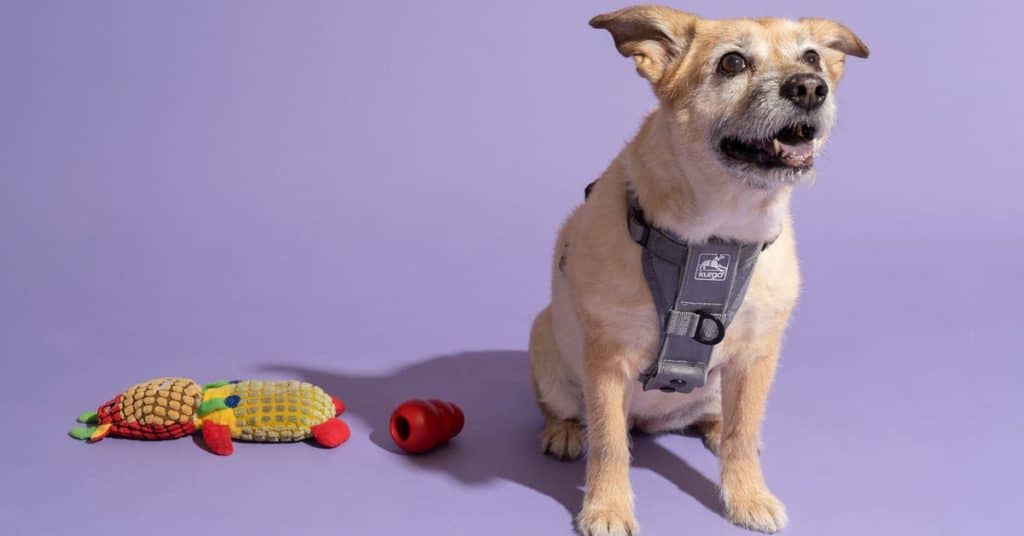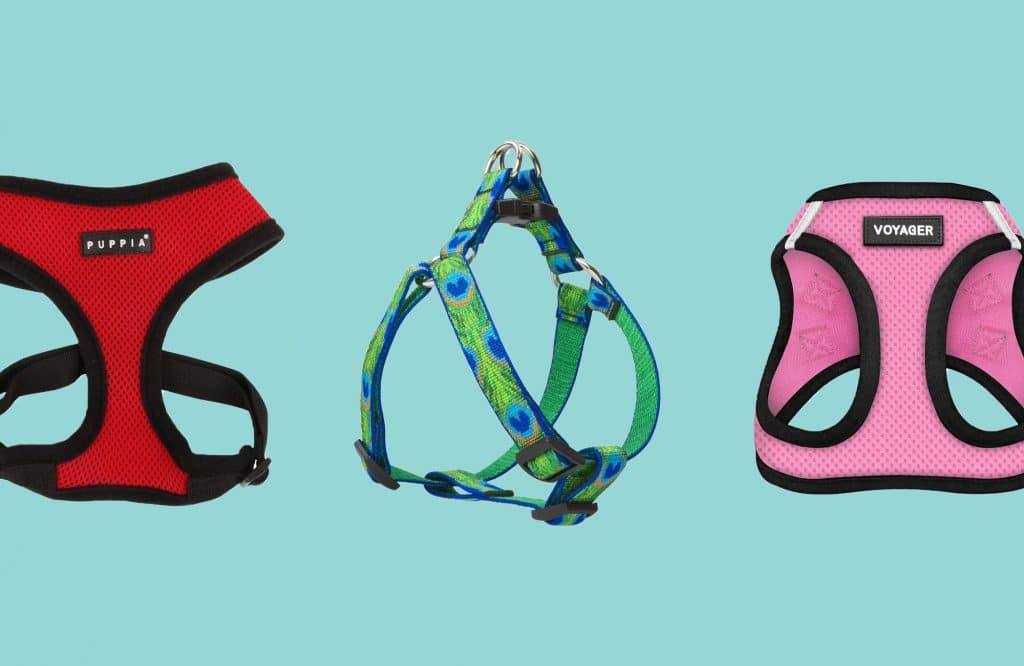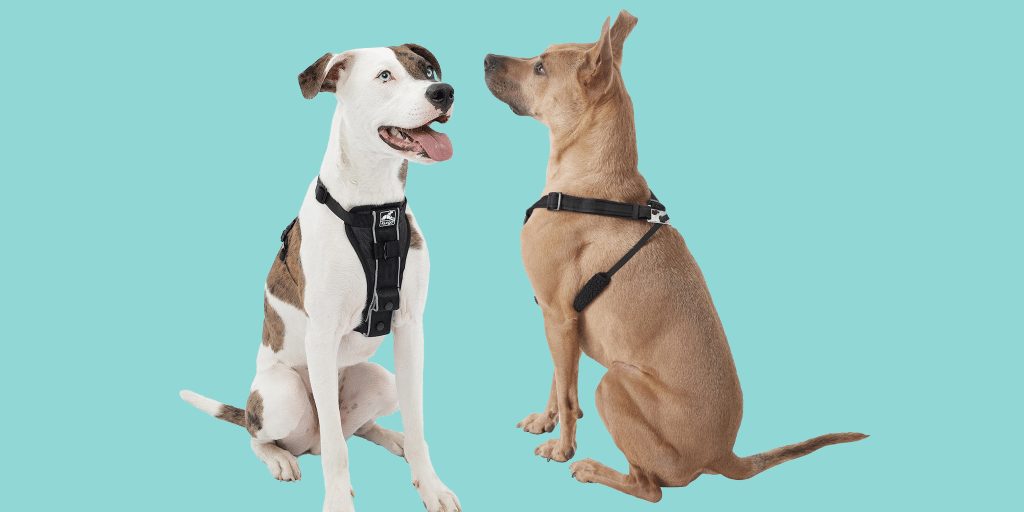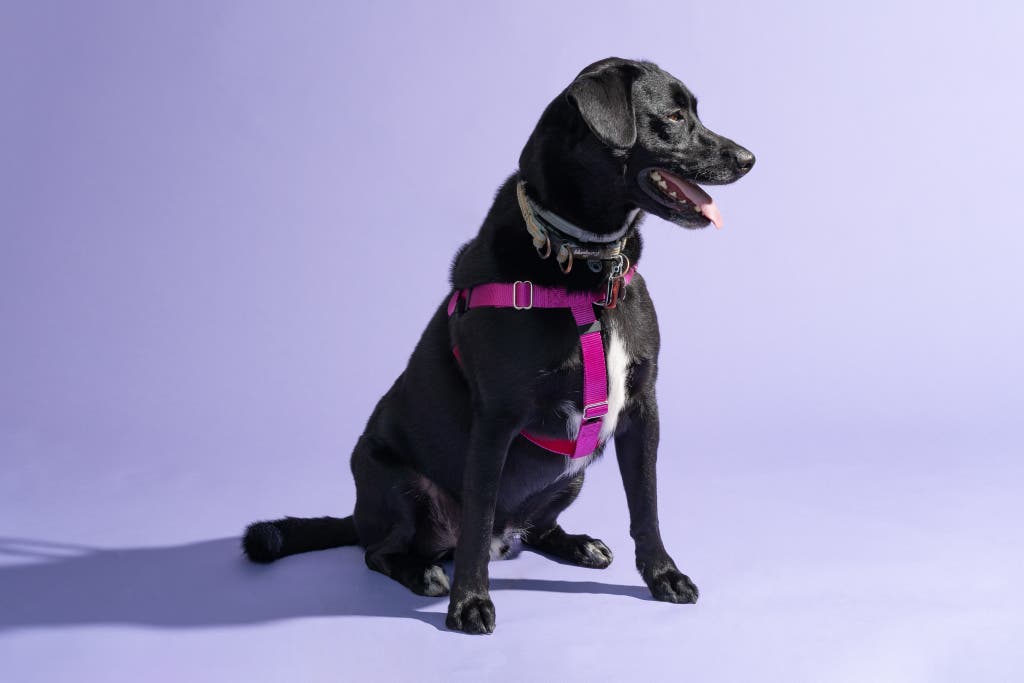Looking out for our furry friends is a top priority, including keeping them safe during their daily adventures. When it comes to harnesses for dogs, finding the right one can be overwhelming with the numerous options available.
This article will explore the different types of harnesses and highlight the safest choice for our beloved pets. Let’s ensure our dogs are secure and comfortable on their walks while giving us peace of mind.
This image is the property of thedognerd. Hu.
1. Traditional Harness
a. Description
The traditional harness is a classic and straightforward option for dog owners. It comprises straps around the dog’s chest and torso, with a ring at the back to attach the leash. The design ensures that the pressure is evenly distributed across the dog’s body, making it a comfortable choice for many dogs.
b. Pros
One of the main advantages of a traditional harness is its simplicity. It is easy to put on and take off, making it convenient for the dog and the owner. Additionally, the even distribution of pressure helps to prevent strain on the neck and throat, making it a safer option for dogs with respiratory issues or small breeds prone to neck injuries.
c. Cons
While the traditional harness offers many benefits, it may not be ideal for dogs who tend to pull on the leash. This type of harness does not provide as much control over the dog’s movements, and the back attachment may allow the dog to exert more force when pulling. If your dog is a strong puller, you may need to consider other harness options for better control.
2. Front-Clip Harness
a. Description
As the name suggests, a front-clip harness has a leash attachment on the front of the dog’s chest. This design redirects the pulling force towards the side, causing the dog to turn towards the owner instead of pulling forward. The front attachment also allows for better control and discourages pulling behavior.
b. Pros
Front-clip harnesses are particularly beneficial for dogs that pull on the leash. It provides better control over their movements, making walks more enjoyable and safer for the dog and the owner. This type of harness also helps to discourage pulling behavior by redirecting the force and promoting more attention toward the owner.
c. Cons
While a front-clip harness can be effective in curbing pulling behavior, it may not be suitable for all dogs. Dogs already well-trained on loose leash walking may find the front attachment restrictive and uncomfortable. Additionally, the side pull can sometimes cause dogs to twist their bodies, potentially leading to discomfort or strain if not correctly fitted.
3. Back-Clip Harness
a. Description
The back-clip harness is similar to the traditional harness, with the leash attachment at the back of the dog. This type of harness is widely available and is a popular choice among dog owners.
b. Pros
The back-clip harness is easy to put on and take off, making it a convenient option for everyday use. It allows for comfortable movement as the leash attachment is positioned on the dog’s back. This can be suitable for well-behaved dogs who do not pull excessively.
c. Cons
Although the back-clip harness is a common choice, it may not suit dogs that tend to pull on the leash. The back attachment can encourage pulling behavior, as the force is directed toward the dog’s chest instead of redirecting it. A different harness design may be more effective for dogs that require more control during walks.
4. No-Pull Harness
a. Description
A no-pull harness is specifically designed to discourage pulling behavior in dogs. It typically features a front attachment point on the chest and an additional back attachment point for increased control.
b. Pros
A no-pull harness offers excellent control over a dog’s pulling behavior. The front attachment helps to redirect the pulling force, encouraging the dog to turn towards the owner and discouraging pulling forward. The additional back attachment can be used with the front attachment for maximum control during walks. This type of harness is particularly beneficial for dogs that require extra training and assistance in breaking their pulling habits.
c. Cons
While a no-pull harness can discourage pulling, it may not suit all dogs. Some dogs may find the front attachment restrictive or uncomfortable, and it may take time to adjust to the harness. Proper fitting and gradual training are essential to minimize discomfort or potential strain.
This image is the property of cdn.thewirecutter.com.
5. Step-In Harness
a. Description
A step-in harness is a type of dog “step into” to put it on. It consists of two loops that go around the dog’s front legs and are connected by a strap on the dog’s chest or back.
b. Pros
The step-in harness is convenient to put on and take off, especially for dogs that dislike having their legs lifted or their heads restrained. It provides a secure fit around the body and offers reasonable control during walks. Step-in harnesses are available in various styles and materials, making it easy to find one that suits your dog’s needs and preferences.
c. Cons
Some step-in harnesses may be less adjustable than other designs, making it challenging to fit dogs with unique body shapes or sizes properly. Additionally, the strap connecting the loops may rub against the dog’s chest or back, causing discomfort or irritation if not positioned correctly. Choosing a step-in harness that is adjustable and fits securely is crucial to prevent any issues.
6. Vest Harness
a. Description
A vest harness is a stylish and comfortable option for dogs. It resembles a vest that wraps around the dog’s torso and fastens with buckles or Velcro.
b. Pros
The vest harness offers a secure and comfortable fit for dogs of different sizes and shapes. The wide straps distribute pressure evenly across the chest and torso, reducing the risk of strain or injury. Additionally, many vest harnesses come with reflective or customizable patches, making them a popular choice for service dogs or dogs in training.
c. Cons
Vest harnesses may not control a dog’s movements as much as other designs. The back attachment may allow dogs to exert more force when pulling, making it less suitable for strong pullers. However, some vest harnesses include a front attachment point to help with control. Proper fitting is crucial to ensure the vest harness sits comfortably on the dog’s body without causing any discomfort or chafing.
This image is the property of hips.hearstapps.com.
7. Head Halter
a. Description
A head halter is a harness that fits over a dog’s muzzle, similar to a horse’s halter. It has straps around the dog’s head and behind the ears, allowing the owner to guide the dog’s movements.
b. Pros
A head halter provides excellent control over a dog’s movements, making it a valuable tool for training and managing solid pullers. It redirects the dog’s attention towards the owner, discouraging pulling or lunging behaviors. The design also prevents pressure on the dog’s throat or trachea, making it suitable for dogs with respiratory issues or neck injuries.
c. Cons
Some dogs may find the head halter uncomfortable, mainly if they are not accustomed to wearing it. It requires proper fitting and gradual training to ensure the dog feels comfortable and does not resist wearing it. Additionally, head halters should not be used with excessive force or jerking motions, which can cause neck strain or injury. It is essential to use a head halter under the guidance of a professional dog trainer.
8. Martingale Harness
a. Description
A martingale harness combines traditional harness design with a limited-slip collar. It has a strap that wraps around the dog’s chest like a traditional harness and another loop around the dog’s neck, tightening slightly when the dog pulls.
b. Pros
A martingale harness offers a gentler form of control compared to a traditional martingale collar. The tightening loop reduces the dog’s risk of slipping out of the harness while allowing for comfortable movement. It can be a suitable option for dogs that require extra security but do not respond well to the pressure of a regular collar or harness.
c. Cons
While a martingale harness can provide more control, improper fitting is risky if not adjusted correctly. The tightening loop should be snug enough to prevent slipping but not too tight to cause discomfort or restrict the dog’s breathing. Regular monitoring of the fit and adjustment is necessary to ensure the dog’s safety and comfort.
This image is the property of hips.hearstapps.com.
9. Escape-Proof Harness
a. Description
An escape-proof harness is designed to prevent dogs from slipping out of their harnesses. It usually has additional security features, such as multiple clips or buckles, to ensure a secure fit.
b. Pros
The main advantage of an escape-proof harness is its enhanced security. It provides peace of mind for dog owners, especially those with dogs with a knack for wiggling out of traditional harnesses. Escape-proof harnesses are often used for dogs with anxiety or fear-based aggression, as they prevent potential escape attempts during stressful situations.
c. Cons
While an escape-proof harness provides added security, it may not be necessary for all dogs. The additional clips or buckles can make putting on or taking off more challenging, especially for dogs not accustomed to wearing a harness. It is essential to consider the balance between security and convenience when choosing an escape-proof harness for your dog.
10. Car Harness
a. Description
A car harness is designed to secure a dog safely during car rides. It typically has a sturdy construction with attachment points that can be connected to a seatbelt or car harness attachment. This ensures that the dog remains secure and restrained during travel.
b. Pros
A car harness is essential for keeping a dog safe while traveling. It prevents the dog from moving around or being thrown in the event of sudden stops or accidents. A well-fitted car harness can provide peace of mind for the owner and the dog, ensuring a secure and stress-free travel experience.
c. Cons
Not all car harnesses are created equal, and choosing one that is crash-tested and approved for use in vehicles is essential. Improperly fitted or low-quality car harnesses may not provide adequate protection, putting the dog at risk during car rides. Researching and investing in a reliable and safety-certified car harness for your beloved furry friend is crucial.
In conclusion, the safest type of harness for a dog depends on various factors, such as size, behavior, and specific needs. It is essential to consider these factors and consult with a professional dog trainer or veterinarian before selecting a harness. Whether it is a traditional harness, front-clip harness, no-pull harness, or any other type, the priority should always be our furry companions’ comfort, safety, and well-being during their walks and adventures.
This image is the property of cdn.thewirecutter.com.

